2025-06-25 ローレンスリバモア国立研究所(LLNL)
 Schematic illustration of the experimental setup. A beryllium capsule (yellow) is compressed, heated and probed by an X-ray source (pink). The scattered photons (purple) are collected by a detector (black). The green dots represent the beryllium ions and the blue-red clouds their electrons. (Credit: T. Dornheim et al.)
Schematic illustration of the experimental setup. A beryllium capsule (yellow) is compressed, heated and probed by an X-ray source (pink). The scattered photons (purple) are collected by a detector (black). The green dots represent the beryllium ions and the blue-red clouds their electrons. (Credit: T. Dornheim et al.)
<関連情報>
- https://www.llnl.gov/article/53076/computational-trick-enables-better-understanding-exotic-state-matter
- https://www.nature.com/articles/s41467-025-60278-3
高密度量子プラズマにおける電子相関の解明 Unraveling electronic correlations in warm dense quantum plasmas
Tobias Dornheim,Tilo Döppner,Panagiotis Tolias,Maximilian P. Böhme,Luke B. Fletcher,Thomas Gawne,Frank R. Graziani,Dominik Kraus,Michael J. MacDonald,Zhandos A. Moldabekov,Sebastian Schwalbe,Dirk O. Gericke & Jan Vorberger
Nature Communications Published:02 June 2025
DOI:https://doi.org/10.1038/s41467-025-60278-3
Abstract
The study of matter at extreme densities and temperatures has emerged as a highly active frontier at the interface of plasma physics, material science and quantum chemistry with relevance for planetary modeling and inertial confinement fusion. A particular feature of such warm dense matter is the complex interplay of Coulomb interactions, quantum effects, and thermal excitations, making its rigorous theoretical description challenging. Here, we demonstrate how ab initio path integral Monte Carlo simulations allow us to unravel this intricate interplay for the example of strongly compressed beryllium, focusing on two X-ray Thomson scattering data sets obtained at the National Ignition Facility. We find excellent agreement between simulation and experiment with a very high level of consistency between independent observations without the need for any empirical input parameters. Our results call into question previously used chemical models, with important implications for the interpretation of scattering experiments and radiation hydrodynamics simulations.



